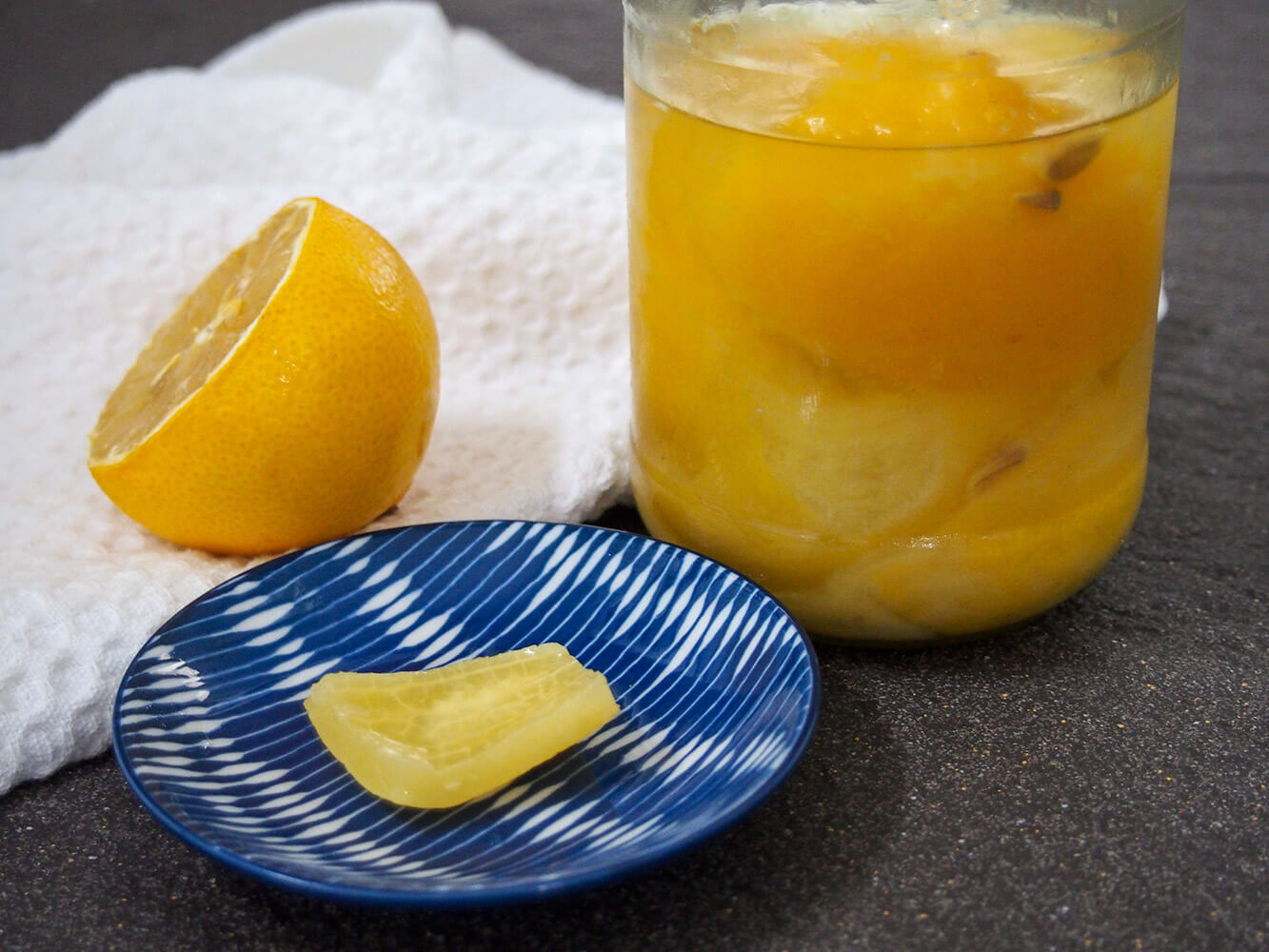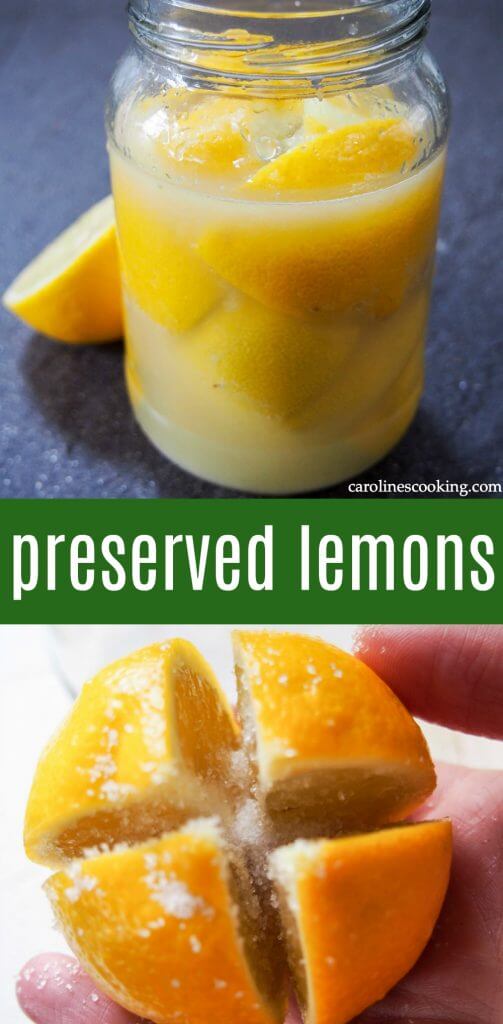Preserved lemons are a common ingredient in Moroccan cooking, as well as other countries in the Mediterranean. They're so easy to make and add a wonderful salty-tart flavor and depth to a whole range of dishes from traditional tagines to salads.

This post may contain affiliate links, where we earn from qualifying purchases. See more details in the policy page.
Many different cuisines have a few flavors that they often incorporate into dishes. Spanish recipes often use garlic and paprika, Levantine dishes have a lot of mint and lemon.
Some cuisines have spice blends that appear often (like Indian garam masala or Lebanese seven spice) as well as sauces.

Preserved lemons are basically one of those common ingredients in Moroccan cooking, as well as some other places. They're incredibly easy to make, using just lemons and salt, but the flavor they can add to a dish is truly amazing.
One of the best-known uses for them is in a popular chicken tagine with preserved lemon and olives, but they're really much more versatile than that. Think of anything you might want to add a lemon flavor to, but with an extra depth to it.

What kind of lemons are best?
The varieties of lemons traditionally used for this tend to be on the smaller side and with a thinner pith. In other words, bigger is not better in this case. The pith, just as in other dishes like marmalade and limoncello, can add a sourness.
Many recipes recommend using Meyer lemons which are certainly a good fit. If you can't find those, then smaller regular lemons are best.
One other thing to note is ideally, use unwaxed, organic lemons. This limits the impurities you'll get in the preserving liquid. If you can't find any, then just make sure you give them a very good wash.

Do you need a special salt?
In general, no, you don't need to rush out and buy a particular salt as long as what you have is not iodized. This is in line with what you'd choose for making pickles etc.
The iodine can impact the flavor as well as the color, in some cases. Also, it can have an anti-caking agent which you don't really want in there here.

Steps to make preserved lemons
As I say, these are really easy to make in just a few steps. You just need some patience to allow them to mature. Some versions add a few spices in with the lemon and salt, but I've kept things simple here.
- Trim the stem end off the lemons.
- Add some salt to the bottom of a sterile jar.
- Sit a lemon on the trimmed end and cut down almost cutting through in a cross shape, leaving it just joined on the one end.
- Slightly open up the lemon and sprinkle salt inside the cuts.
- Place the lemon in the jar then repeat with 2 more lemons.
- Press the lemons down in the jar well to release some juice. Take another half lemon and squeeze more juice in, split this lemon half in two then add to the jar.
- Leave overnight then push down, adding more lemon juice if needed to cover lemons.
- Leave at least 3 weeks to mature, in either a cool place or fridge.

How do you use preserved lemons?
Once the lemons have matured, you can keep them in the fridge for a good 6 months to use as and when you need them. Then, when you want to use one or part of one, just take out what you need and rinse it off.
Depending on what you are using it for, you often remove the inner flesh and just use the skin. Then, in most cases, you dice it up and add to the dish.

As I mention above, a popular way to use them is in a tasty chicken tagine, but you'll find them in other main dishes, couscous and more in Moroccan cooking. Plus they add such flavor to so much more, like my preserved lemon vinaigrette.
Preserved lemons are easy to make and are a great thing to add to your fridge collection to "make things more interesting". A common ingredient in Moroccan dishes, they also add a wonderful flavor to a whole range of dishes like salad dressings, cocktails and more. Give them a try and get creative!
Preserved lemons
Ingredients
- 3 ½ lemons small or Meyer lemons, ideally organic unwaxed
- 2 ½ tablespoon salt non-iodized
Instructions
- Wash the lemons well, scrubbing any wax off if you were unable to get unwaxed. Trim the stem end off the three whole lemons.
- Add around ½ tablespoon salt to the bottom of a sterile mason jar or medium jam jar.
- Sit a lemon with the trimmed end down on a cutting board and cut down to leave just a little still joined at the bottom (around ⅓in/1cm from bottom). Cut again at right angles to make a cross shape.
- Slightly open up the lemon and sprinkle 1/t tablespoon salt inside the cuts.
- Place the lemon in the jar then repeat with 2 more lemons.
- Press the lemons down in the jar well to release some of the lemon juice. Take another half lemon and squeeze more juice into the jar, then split this lemon half in two and add to the jar, pushing half down each side. Sprinkle the remaining salt over the top and put the lid on the jar.
- Leave the jar overnight in a cool, dark place then the next day push down the lemons again to release more juice. If needed, add more lemon juice to ensure the lemons are just covered.
- Cover with lid again then leave the jar at least 3 weeks to mature, in either a cool place or fridge. The lemons are good to use when the skin has softened and white pith is slightly opaque. Rinse off the piece you plan to use before using.
Notes
Nutrition
See some of my favorite cooking tools and ingredients in the Caroline's Cooking Amazon store.
Remember to pin for later!





Jeannette
What a wonderful way to add flavour and to use extra lemons! Love that is lasts for so long as well!
Caroline's Cooking
It really is great both for adding flavor and to use up lemons - I highly recommend making some!